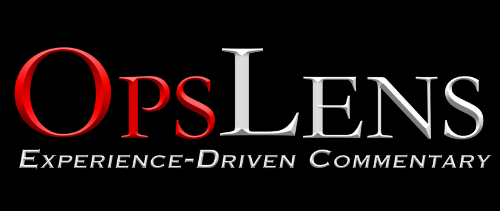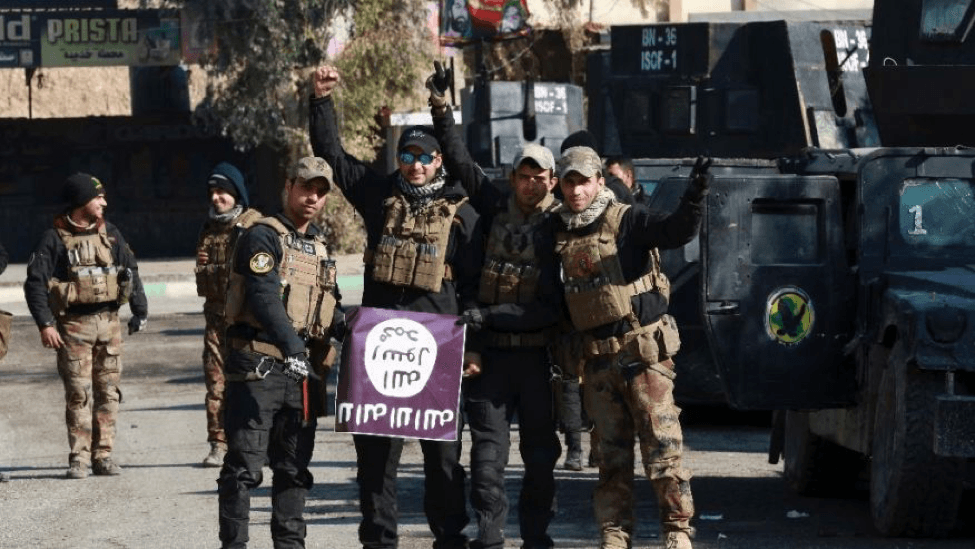By Mike Furlong:
January 25, 2017
With the impending operational and tactical battle for western Mosul, between the Iraqi Military Coalition and the Islamic State of Iraq and Syria’s (ISIS or ISL or IS) has now reached a pivotal juncture—with global-strategic level impact. The governments of Iraq and the United States would benefit strongly by the defeat of ISIS in Mosul. ISIS’ defeat in Mosul would seriously degrade its credibility and viability to deliver its self-declared global caliphate against the “non-believers.” ISIS’ recruiting would plummet. So, let us treat this upcoming final attack on western Mosul with the importance that it warrants.
In my companion article regarding ISIS vulnerabilities in western Mosul fight (OpsLens, January 25, 2017), I highlighted specific ISIS vulnerabilities that must be exploited. With IMC forces about to make its final attack on western Mosul, in the coming days, it would be wise to take two deep breaths and further refine IMC’s operational attack plan. Take the opportunity to win decisively, with fewer casualties.
This is the third article, in a series of three articles, regarding the IMC’s ongoing operation to reclaim Mosul, Iraq, from the occupying ISIS fighters—a radical Islamic terrorist organization.
For background reading regarding this article, I suggest OpsLens.Com’s: “The Reclaiming of Mosul: 2016 Operational Update” (January 6, 2017), “The IMC’s Limited Progress in Reclaiming Mosul” (January 17, 2017), and “The Mosul Fight: An Update Chronicling IMC’s Success in Taking Eastern Mosul” (January 24, 2017).
I want to caveat my suggestions below by saying that my remarks are made with the utmost respect for what the IMC and the U.S. military’s so-called “advisers and assisters” have accomplished by reclaiming eastern Mosul. Moreover, I provide these suggestions to stimulate thinking and adaptive planning.
I do not mean to suggest that the IMC leadership is not already thinking about (or executing) these principles and tactics. If only one of these suggestions helps the IMC save casualties, then this academic effort for my “warrior brothers” will be worthwhile.
My brother, Shane Furlong, a retired U.S. Army Technical Communications Officer, provided me these gratuitous, common-sense thoughts while writing this article: “Head-on assaults against a fortified defensive perimeter are very expensive militarily (e.g., high casualties suffered on D-Day in WWII; Pickett’s Charge in the U.S. Civil War). … ISIS cannot defend every inch of its perimeter with just 5000 ISIS fighters. I would use aerial drones extensively to find the weak perimeter points. The French depended on fixed defensive positions on the Maginot Line. Another mistake. … any injection of SOF forces inside the perimeter would be invaluable for intel gathering and probing attacks against ISIS’ morale. It’s hard to focus on your fields of fire to the front, when you can hear IMC troop activity, in what should be your safe rear-areas.”
My suggestion is to take a quick review from the “Principles of War” perspective (just nine of them) and the “Battlefield Operating Systems” perspective (just seven of them) regarding IMC’s existing attack plan for western Mosul. I am confident that new ideas and productive, life-saving, tactics, will probably flow from this extra day of planning investment.
The U.S. military’s “Principles of War” are: Objective; Offensive; Mass, Economy of Force; Maneuver; Unity of Effort/Command; Security; Surprise; and Simplicity.
The U.S. military’s “Battlefield Operating Systems” are: Command and Control; Intelligence; Maneuver; Fire Support; Air Defense Artillery; Mobility, Counter-Mobility, and Survivability; and Combat Service-Support.
After significant casualties suffered during the first three months of combat to reclaim Mosul, the Iraqi Golden Division deserves these “additional planning” considerations by the IMC Commander. The Golden Division—the Iraqi Army’s most elite special operations forces—have spearheaded the Mosul fight that has reclaimed eastern Mosul.
After studying ISIS’ vulnerabilities (a companion article posted today on OpsLens.com), I believe that ISIS in western Mosul has several exploitable weaknesses for IMC to consider in its upcoming final attack plans for western Mosul.
Suggested IMC Major Considerations and Perspectives:
1) ISIS’ supreme headquarters in Raqqa has its own survival problems; therefore, ISIS Mosul fighters are not likely to be reinforced or resupplied. Every day makes them weaker. Additional and limited raids (or probes) by U.S. SOF in Syria, timed and synchronized with the western Mosul probes and attacks, can add to the command and control and psychological problems for ISIS, writ large.
2) ISIS in Mosul is surrounded by IMC and cut-off from its supply lines. Time is not on ISIS’ side. IMC forces can, therefore, pick when and where to attack ISIS in western Mosul. IMC can use some time (days to a week) to make sure they are planning every detail and rehearsing before the attack. Among other considerations, use this extra time to collect more and specific intelligence to pinpoint ISIS’ forces locations and tunnels. Surge all intelligence collection platforms (e.g., drones, cell phones collection, etc.) from the Coalition Military partners during this period. Identify the critical nodes of ISIS’ defenses and headquarters.
3) Leverage this better “situational understanding” of ISIS to tweak IMC’s current attack plans and make them more “insightful and exact.” Conduct multiple reconnaissance probes and “harassing/fixing fires” against ISIS during these extra days to prevent ISIS forces from sleeping. Wear them down before the big fight. ISIS executed 25 of its fighters for fleeing the battle from eastern Mosul back into western Mosul. ISIS’ fighters are now at their lowest point psychologically.
4) Tighten the cordon of conventional forces around the suburbs of western Mosul. This will enable IMC to use its conventional forces units to assist in probing, deceiving, and harassing ISIS forces before the final attack begins. Use these fixing fires to enhance IMC’s deception plan and to achieve tactical surprise about the times and locations of IMC’s actual attack plans.
5) IMC must apply strict security of its operational plans (OPSEC) to achieve tactical surprise for its final attack against ISIS. IMC must, therefore, use its deception plans to conceal their true intent for the final attack.
6) The remaining 5000 (+/-) ISIS fighters in western Mosul are too small to react to multiple IMC attacks simultaneously. Spread ISIS forces across wider locations and troops available; thereby, enhancing IMC’s positive force ratios in the mini-battles. This IMC effect on ISIS’ weakness could be intensified by IMC feints, ruses, and deception activities.
7) IMC’s insightful plans must include massing its Counterterrorism Services/special operations forces against the weakest ISIS defense locations. If planned and executed properly, these deceptions, probes, feints, ruses, and harassing/fixing fires can confuse ISIS from understanding IMC’s actual attack plans and timing of the main attack.
8) Five-thousand ISIS fighters can’t control 500,000 to 750,000 Mosul civilians that will flee their entrapment. Fleeing civilians can provide actionable intelligence (e.g., tunnel entrances, car-bomb locations, etc.) for IMC. Multiple probing attacks, from different directions, can open-up escape corridors for fleeing Mosul civilians. Fleeing civilians can provide quick actionable intelligence for helping the fluid IMC forces maneuver to defeat ISIS with fewer IMC and civilian casualties. Do this wisely. Expect inevitable out-flows of Mosul civilians that can, if not planned for, and managed properly, disrupt IMC attacks. Don’t forget to address the ethnic issues. Quickly review the most recent successes in the IMC fight to reclaim Ramadi and Falluja from ISIS.
9) Plan beforehand, and integrate, military and refugee/displaced persons plans for this battle. The Mosul civilians will not flow all at once, and all to one location. This suggests the need for stockpiles of water, food, and medical treatment. Oliver North’s recent hour-long documentary on these matters, aired on the Fox News Channel from Bartella, Iraq, on January 9, 2017.
10) ISIS’ cell-phone communications can be jammed by IMC at a time and place of IMC’s choosing. This can degrade severely ISIS’ command and control during a fast, fluid, battle in western Mosul—especially, during night raids.
11) ISIS is vulnerable to night attacks now that IMC SOF have become more proficient at night attacks during its successes in eastern Mosul. ISIS counter-fires will be degraded. This advantage will enable IMC forces to be more successful in their attacks, while reducing both IMC forces and Mosul civilian casualties. Also, make preliminary staging moves at night (for OPSEC reasons) before the final attack.
12) Now, IMC, is shooting down ISIS’ unmanned aerial drones with classified technical assistance from U.S. forces. This degrades ISIS’ intelligence collection and situational understanding. Mass resources against ISIS drones.
13) IMC’s new, more aggressive, (mostly, U.S. artillery) fire support, is bombarding key ISIS operational nodes while keeping civilian casualties relatively low. This firepower has enabled the IMC ground forces to re-capture significant operational territory in eastern Mosul. These highlights of ISIS’s tactical and operational weakness have become more pronounced since IMC’s operational reset on December 29, 2017. Plan for stockpiling vast amounts of smoke rounds and capabilities for the eventual frontal crossing of the Tigris River. This will obscure ISIS’ fields of fire and save lives. Can U.S. AC-130 gunships be surged for this final attack?
14) Also, IMC’s new found tactical success in the Mosul fight suggest the significance of U.S. advisers’ mentorship at the leading edge of the fight. Hopefully, the U.S. commander of OIR will receive authority to temporarily loosen the restrictions on the Rules of Engagement (ROE) for this western Mosul fight.
15) With loosened ROE, consider the feasibility of assuming slightly more calculated risks:
- Conducting a coordinated U.S. SOF raid to destroy a critical ISIS headquarters/unit/asset/facility that complements and enhances the Golden Division’s mission. U.S. “black SOF” did this successfully with the Kurt Muse (Sr. CIA operative) rescue during the Panama Invasion. This special mission was executed simultaneously with the overall attack to seize 33 other objectives.
- For example, “Thunder Runs with a formation of M-1 Tanks and Armored Personnel Carriers” to seize the Mosul Airfield. Timed with the Main Attack. U.S. forces used “thunder runs” to successfully collapse the defenses of Baghdad in spring 2003.
16) Don’t forget the “hand-off” considerations for governing Mosul after the fight. IMC should identify, have contact with, and discuss key plans for those Mosul leaders that must quickly assume control of the resulting chaos after the battle.
Again, I applaud the IMC forces, and their supporting U.S. forces, for their intermediate success in reclaiming eastern Mosul.
A few parting questions: If the final attack to reclaim all of Mosul has global-strategic impact, should President Trump, his Secretary of Defense, and applicable generals be discussing options to temporarily provide surge support to Iraqi Prime Minister Abadi for this pivotal battle? If so, should POTUS Trump, National Security Advisor Flynn, and Secretary Mattis be discussing these options with their Iraqi counterparts? Just a thought.
Michael Furlong is a Senior OpsLens Contributor. Furlong is a career Army Infantry Officer, Battalion Task Force Commander, Combat Veteran, and retired Defense Intelligence Senior Executive Service.
To contact or book OpsLens contributors on your program or utilize our staff for your story, contact [email protected]

















